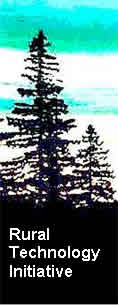|
2003
|
Save or Print a PDF
copy of Fact Sheet #18
The management challenges facing small-scale family forest
landowners are unique. Forest fire danger, ecosystem fragmentation,
and wildlife conflicts are among the issues facing forest
landowners at the urban-rural interface. Many of these landowners
are new to forest ownership, and although they may have small
individual holdings, collectively they control a substantial
amount of private and public resources (Blatner et al. 1991;
Bliss et al. 1994). Washington State University Natural Resources
Extension faces the increasing educational challenge of forest
fragmentation and parcelization as more people move from the
cities into the rural/urban interface. Rural communities are
growing in population, resulting in an increase of forest
landowners with smaller sized forest parcels (Sims 2000).
This shift in forest landowner demographics, along with the
significant political influence this group enjoys, underscores
the importance of the small-scale forest landowner in Washington
State. A recent study at Washington State University compared
Washington small-scale family forest landowners owning forested
properties in metropolitan counties to those with properties
in rural counties. Using data from a 1999 survey of landowners,
researchers identified the use of educational programs by
forest landowners in metro and rural counties and the potential
significance of acreage size on participation.
|
 |
The results of this survey indicate that the county location of
forestland (either in rural or metropolitan) has little to do with
Non-industrial Private Landowner (NIPF) use of forestry educational
programs. However, the survey does suggest that those educational
programs currently available may be of more interest to larger acreage
landowners than smaller acreage landowners, which implies the programs
may not be meeting the needs of all the forest landowners in the
state of Washington. Respondents in both large and small acreage
classes had similar reasons for forestland ownership but indicated
several different management interests and land-use activities,
regardless of county classification. Moreover, landowners who had
attended an extension educational program were more likely to actively
manage their forestland for multiple uses, regardless of acreage
size or county of ownership.
It is generally believed that forest landowners with larger acreages
take a more active management approach, and with a more multi-use
philosophy towards their forests than do landowners with smaller
acreages (Blatner, et al. 1991; Jones, et al. 1995). The results
of this study suggest that when provided with information and education,
small acreage landowners are just as likely to actively manage their
forests for multiple use, as are larger acreage owners. However,
larger ownerships appear to use extension-based forestry programs
and materials more often than do small ownerships. There are some
possible explanations for this.
One reason is that natural resource and forestry extension programs
have traditionally focused on impacting acres rather than individuals.
For example, the coached planning classes are often advertised to
landowners with 20 or more acres, although landowners with fewer
than 20 acres are welcome to take the course. Also, many state run
cost-share and incentive programs require a minimum of 20 acres
for eligibility. However, with the increased parcelization of forests,
targeting people instead of acres may provide the "biggest
bang for the buck."
Respondents owning less than 20 acres were less interested in active
management of their forests. These landowners may not have a significant
volume of timber available for harvest because of the relative size
of their holdings. Or their forests may be in a young age-class
immediately after reforestation. Nonetheless, even if they are interested
in alternative management programs, few are offered.
A second explanation may be that non-timber management educational
programs of interest to small urban landowners, such as managing
for songbirds and other wildlife viewing opportunities or non-timber
products such as mushrooms, are not being offered.


A third reason may be unfamiliarity with available educational
and technical programs. There has always been a feeling of disconnect
between rural and urban communities regarding natural resource management,
especially relating to forests. Forest owners that live in urban
population centers and travel to their forestlands may feel they
don't fit into the traditional forest landowner demographic. However,
this demographic is changing as the boundaries between rural and
urban landscapes becomes hazy. Indeed, this study supports the concept
of the blurred rural-urban boundary, as there were no differences
seen in landowner attitudes and interest between rural or metropolitan
counties. The face of the forest landowner in Washington State is
changing, possibly due to an ever increasing number of regulations
and tough state Forest Practice rules. Many industrial forests are
subdividing and selling off their forestlands in response to the
"…increasing economic difficulties of meeting state and
federal land-use regulations" (Thorud, 2000). People who desire
a more rural lifestyle may be unaware of available forestry and
natural resource extension programs. Forestry Extension needs to
expand its strategies and formats to meet the challenges of the
changing environment. The increased number of people moving from
city centers into rural communities and the subsequent expansion
of the rural-urban interface suggests that an effective approach
in reaching more forest landowners in the state may be through partnering
with traditionally urban associations. Organizations such as garden
clubs, neighborhood associations, local non-profit groups, Master
gardeners, and local libraries have existing information delivery
systems that should be explored.
References:
- Blatner, K.A., D.M. Baumgartner, and L.R. Quackenbush. 1991.
NIPF Use of Landowner Assistance and Education Programs in Washington
State. W.J. App. For. 6 (4): 90-94.
- Bliss, J.C., S.K. Nepal, R.T. Brooks Jr., and M.D. Larsen. 1994.
Forest Community or Granfalloon? Do Forest Owners Share the Public's
Views? J. For. 92 (9): 6-10.
- Harmon, A.H., S.B. Jones, and J.C. Finley. 1997. Encouraging
Private Forest Stewardship Through Demonstration. J. For. 95
(6): 21-25.
- Jones, S.B., A.E. Luloff, and J.C. Finley. 1995. Another Look
at NIPF's: Facing Our Myths. J. For. 93 (9): 41-44
- Sims, R. 2000. Forests at Risk. Summit 2000: Washington Private
Forests Forum, Olympia, Washington.
- Thorud, D.B. 2000. Introductory remarks at Summit 2000. Summit
2000: Washington Private Forests Forum, Olympia, Washington.
|









